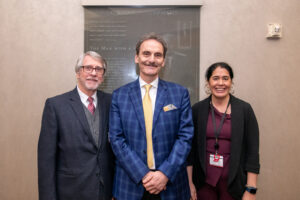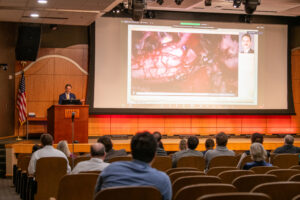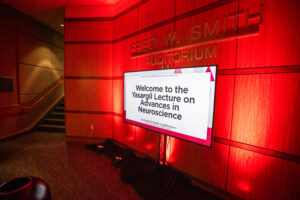View Larger Image

Jacques Morcos, M.D., stands outside the lecture hall in the Jackson T. Stephens Spine & Neurosciences Institute with the institute's director, T. Glenn Pait, M.D. a fellow neurosurgeon.
Image by Bryan Clifton
Renowned Neurosurgeon Praises UAMS Emeritus Professor M. Gazi Yasargil, M.D., at Lecture
| The Fred Smith Auditorium at the University of Arkansas for Medical Sciences (UAMS) became a classroom for neurosurgeons, neurosurgeons-in-training and others Feb. 23, when Jacques J. Morcos, M.D., presented a lecture on cerebrovascular and skull base surgery as part of the M. Gazi and Dianne C.H. Yasargil Lectureship, “Advances in Neuroscience.”
Using videos of surgeries performed by himself and others, Morcos, who is president-elect of the American Association of Neurological Surgeons (AANS), discussed nuances of the two types of cerebrovascular surgeries, which he referred to as “the inseparable twins,” for those in the auditorium and others who attended virtually.
Before he began narrating the videos to focus attention on the microsurgical techniques used and the reasons behind them, Morcos, now professor and chair of the Vivian L. Smith Department of Neurosurgery at the McGovern Medical School at UTHealth Houston, said he was particularly pleased to be part of the Yasargil lecture series.
Morcos said he had long admired the former UAMS professor from Turkey who took emeritus status in 2013 with staff and in July will celebrate his 99th birthday.
“I was attracted to neurosurgery because of the magic he can do,” Morcos said. “Little did we know he would become the neurosurgeon of the last half of the 20th century.”
The Yasargil lectureship began at UAMS in 2008 to honor the man who is considered the father of microneurosurgery and his wife, a nurse who developed a method of organizing surgical instruments for different types of neurosurgeries and founded the European Association of Neurosciences Nurses. The title, “Man of the Century” was bestowed upon Yasargil by the Congress of Neurological Surgeons, for his extraordinary body of work between 1950 and 1999.
In 2022, Turkey issued a postage stamp bearing a photograph of Yasargil and the words, “Prof. Dr. M. Gazi Yasargil.”
Morcos called Yasargil “truly an artist — an artist in his fingers and in his thinking,” observing that “he of course loved art, and always compared neurosurgery to art.”
Morcos’ lecture touched repeatedly on the similarities between neurosurgery and art, and the similarities between the two types of surgeries and how a surgeon’s knowledge of one can help when problems arise with another.
During one video depicting a complex skull-base surgery, he said, “I couldn’t have done this surgery without a certain level of comfortability” with cerebrovascular surgery.
He referred to another of his surgeries, which resulted in a positive outcome, as “a wonderful marriage of skull base and cerebrovascular surgeries.”
Morcos compared “mastering the art” of neurosurgery to mastering the skills of a renowned artist, at one point comparing neurosurgery to the work of the Italian Renaissance artist and scientist Leonard da Vinci.
“Not to discourage the younger among you, who are aspiring to be masters,” he quickly added. “I remind you no master is born perfect. Nobody starts as a master. Practice beats talent all the time.”

After the lecture, Morcos pauses for a picture with Pait and UAMS neurosurgeon Deanna M. Sasaki-Adams, M.D., who has known Morcos for several years.
Displaying earlier and final versions on the large video screen of da Vinci’s well-known drawing, “The Vitruvian Man,” Marcos said, “You need to do many, many drawings on the left, before you can produce something like what you see on your right.”
Morcos, a native of Lebanon, earned his medical degree at the American University of Beirut and completed his residency in neurological surgery at the University of Minnesota Hospital and Clinics. He completed a fellowship in cerebrovascular surgery at the University of Florida College of Medicine and a fellowship in skull base surgery at Barrow Neurological Institute in Phoenix.

